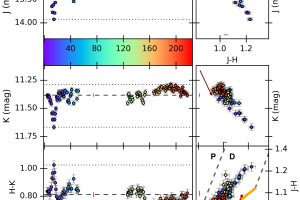Infrared variability in pre-Main Sequence stars. The study: “Near-infrared time-series photometry in the field of Cygnus OB2 association II. Mapping the variability of candidate members” of J. Roquette (University of Exeter/ ICEx – UFMG) recently appeared on A&A

Pre-Main Sequence stars are young stars whose nuclei are still not hot enough to trigger the thermonuclear reactions that will produce energy for the rest of their existence. Some of these stars are called “T Tauri”, and they are surrounded by a protoplanetary disk made of gas and dust, where planetary systems may form. T Tauri stars were classified for the first time in the 1945 by the astronomer A. H. Joy, who claimed that an intense (up to three magnitudes) and even irregular variability is among the main properties of these stars.
Several recent projects, such as YSOVAR (based on observations of pre-Main Sequence stars with the NASA satellite Spitzer) and CSI2264 (based on observations of the pre-Main Sequence stars in the stellar cluster NGC2264 with the satellite CoRoT and other 14 ground- and space-based telescopes) have shown that variability in young stars is a consequence of phenomena associated with the protoplanetary disks or of stellar magnetic activity. In the former cases, variability is due to variable extinction caused by material associated with the disks partially obscuring the star for a short period of time, or to accretion of gas from the disk onto the star, a phenomenon which is intrinsically variable and that produces emission in optical, UV and X-ray bands that can be modulated by stellar rotation. In disk-less stars, variability is associated with magnetic phenomena such as flares, spots, faculae or active regions, which are also intrinsically variable and modulated by stellar rotation. Since non of these phenomena can be directly observed in stars, variability is one of the only methods that can probe them.
This has motivated the study of J. Roquette (University of Exeter/ ICEx–UFMG) on the variability of the pre-Main Sequence stars in the OB stellar association Cygnus OB2. Previous studies, some of which led by astronomers of INAF – Astronomical Observatory of Palermo, have identified more than 5000 pre-Main Sequence stars in Cygnus OB2, both with and without disks. The team led by J. Roquette have analysed a long time series of observations in the infrared JHK bands of the pre-Main Sequence in Cygnus OB2, obtained in 115 nights with the telescope United Kingdom Infra-Red Telescope (UKIRT). From the analysis of these observations, they have found that more than 50% of the stars are variable in the infrared, with 66% characterized by periodic variability, 5% by variable extinction, and the remainder characterized by other type of variability. Authors have also demonstrated the efficiency of variability as criterion to select stars with protoplanetary disks, since about 58% of the stars with disks in Cygnus OB2 could have been selected from their variability. The study is described in the paper: “Near-infrared time-series photometry in the field of Cygnus OB2 association II. Mapping the variability of candidate members“, recently appeared on the journal Astronomy & Astrophysics. Among the coauthors, the astronomer M. G. Guarcello of INAF – Astronomical Observatory of Palermo.
The figure (click here to visualize the entire image) shows the light curve (e.g. the time variation of the detected flux from a given source) of a star with a protoplanetary disk in Cygnus OB2 affected by variable extinction. Left panels show the light curves in the H and K bands (remember that magnitudes are a logarithmic function of fluxes). The bottom left panel shows the light curve in the color H-K (e.g., difference between magnitudes and ratio of fluxes). The right panels show how the position of the star changes in diagrams involving the bands J, H, and K and the colors J-H and H-K. These trajectories are typical of variable extinction.
Mario Giuseppe Guarcello ( follow mguarce)
